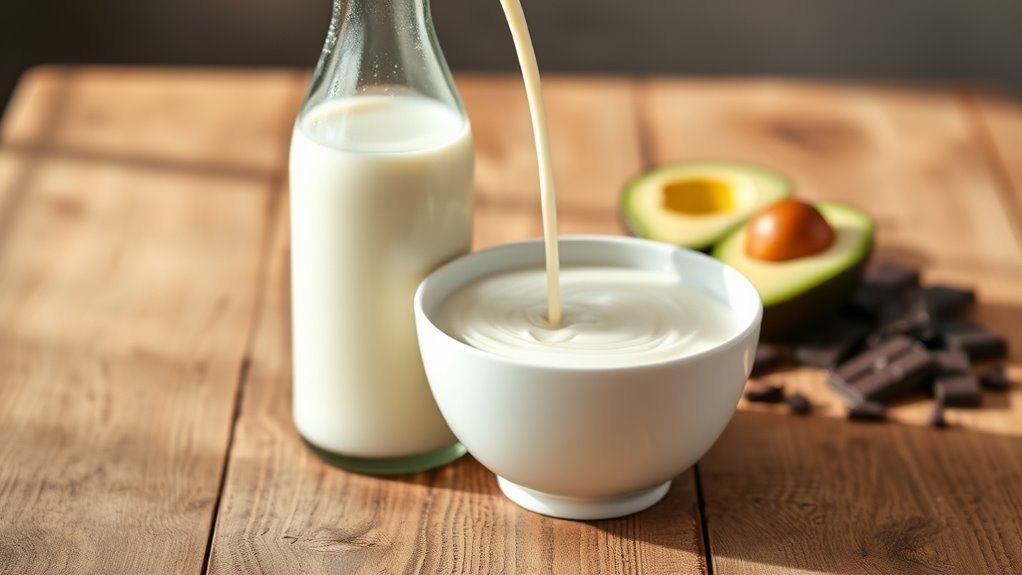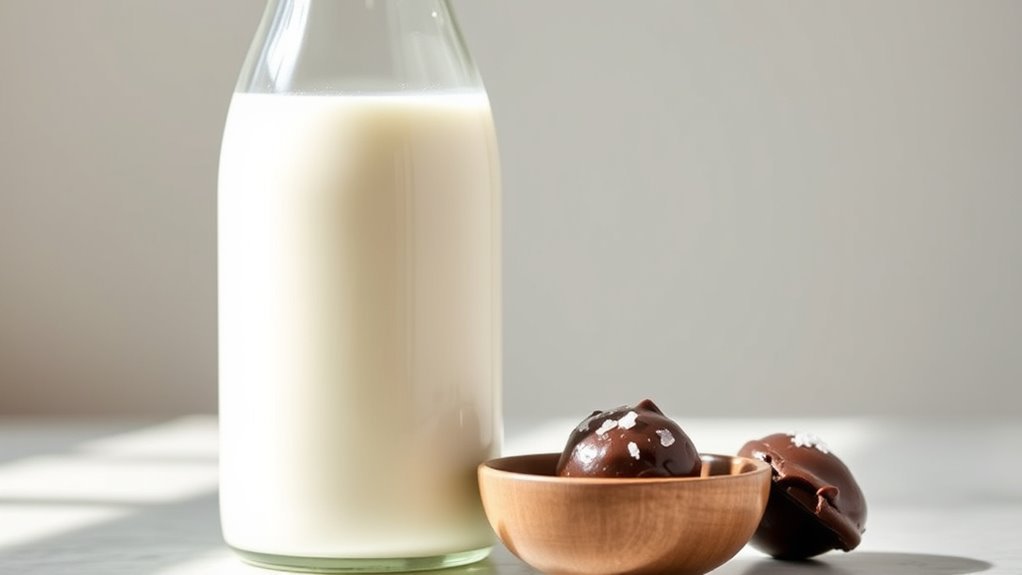Lactose-free milk can fit into your keto diet, offering essential nutrients while managing carbohydrate intake. It contains about 12 grams of carbs per cup, which primarily comes from natural sugars. Compared to regular milk, it’s often easier on digestion without compromising on taste or texture. However, moderation is key to stay within your carb limits. If you’re curious about how to incorporate lactose-free milk effectively, you’ll find more helpful tips ahead.
Understanding Lactose-Free Milk

Although many people enjoy dairy, lactose intolerance can make it difficult to digest regular milk. Fortunately, lactose-free milk offers a great alternative, allowing you to enjoy the creamy texture and taste without the discomfort. This milk is treated with lactase, an enzyme that breaks down lactose, making it more digestible for those with lactose intolerance. In addition to lactose-free options, a variety of milk alternatives exist, such as almond, soy, and oat milk. These alternatives cater to different dietary preferences and can be fortified with vitamins and minerals. When choosing a milk alternative, consider your nutritional needs and personal taste preferences. Embracing these options can help you maintain a balanced diet while enjoying the freedom to choose what you drink.
Nutritional Breakdown of Lactose-Free Milk

When you’re considering lactose-free milk as part of your diet, it’s important to understand its nutritional profile. Lactose-free milk contains similar nutrients as regular milk, including calcium, protein, and essential vitamins, making it a great option for those with lactose intolerance. It typically has about 12 grams of carbohydrates per cup, which is slightly higher than some milk alternatives like almond or coconut milk. However, it’s still lower in carbs compared to sugary beverages. This could be beneficial for those following a keto lifestyle, as long as you account for the carbs. Remember, choosing the right milk alternative depends on your dietary goals, preferences, and how your body responds to different options.
Comparing Lactose-Free Milk and Regular Milk

When comparing lactose-free milk to regular milk, you’ll notice some key differences in nutritional content that can affect your dietary choices. For instance, while both types of milk provide protein and calcium, the carb content in lactose-free milk can vary slightly. Understanding these differences is essential, especially if you’re monitoring your intake for ketosis.
Nutritional Content Differences
While both lactose-free milk and regular milk provide essential nutrients, their nutritional content differs in a few key areas. Lactose-free milk retains similar levels of protein, calcium, and vitamins but lacks the lactose, making it easier for those with lactose intolerance to digest. Regular milk contains lactose, which can sometimes lead to digestive discomfort for those sensitive to it. Regarding calories, the difference is minimal, but lactose-free options may have slightly higher sugar content due to the breakdown of lactose into glucose and galactose. For ideal digestive health, choosing lactose-free milk can be a liberating option, allowing you to enjoy dairy without the unpleasant side effects and still reap the nutritional benefits it offers.
Impact on Ketosis
Although both lactose-free milk and regular milk can fit into a balanced diet, their effects on ketosis can differ considerably. Regular milk contains naturally occurring lactose, which can hinder your ketosis efforts due to its carb content. On the other hand, lactose-free milk is often lower in carbs, depending on the brand, making it a more favorable option for those seeking to maintain ketosis.
| Type | Carbs (per cup) | Ketosis Effects |
|---|---|---|
| Regular Milk | 12g | May disrupt ketosis |
| Lactose-Free Milk | 6-12g | Generally more keto-friendly |
| Milk Alternatives | Varies | Often lower carb options |
Choosing the right milk alternative can support your keto journey while giving you the freedom to enjoy a variety of beverages.
The Carb Content in Lactose-Free Milk
If you’re considering incorporating lactose-free milk into your keto diet, it’s essential to understand its carb content. Lactose-free milk typically contains about 5 grams of carbs per cup, primarily from natural sugars. Since this milk is designed for those who struggle with lactose digestion, it can be a suitable option for many, but you’ll want to account for those carbs in your daily intake. When compared to other milk alternatives, like almond or coconut milk, lactose-free options generally have a higher carb count. If you’re aiming to stay within your keto limits, be mindful of how much you consume. Ultimately, aligning your choices with your nutritional goals is key to maintaining that desired freedom in your diet.
Alternatives to Lactose-Free Milk on Keto
When you’re managing a keto diet, finding suitable alternatives to lactose-free milk can enhance your meal options without compromising your carb limits. Almond milk is a popular choice, as it’s low in carbs and calories while providing a creamy texture. Just make sure to choose unsweetened varieties to keep your carb intake in check. Coconut milk is another fantastic option; it’s rich in healthy fats and can add a delightful flavor to your dishes. Both almond and coconut milk can be used in smoothies, coffee, or baking, giving you the freedom to enjoy your favorite recipes. By incorporating these alternatives, you can maintain your keto lifestyle while still enjoying the creamy goodness of milk without the lactose.
Incorporating Lactose-Free Milk Into Your Keto Diet
When incorporating lactose-free milk into your keto diet, it’s important to understand its nutritional profile and carbohydrate content. This milk can be a great option if you’re looking for a dairy source that fits your macros, but you’ll want to use it wisely to stay within your carb limits. Let’s explore how to effectively add lactose-free milk to your meals while maximizing its benefits.
Nutritional Profile Overview
Lactose-free milk can be a valuable addition to your keto diet, especially for those who want to enjoy dairy without the digestive discomfort that lactose can cause. It’s a great alternative for those with lactose intolerance, allowing you to reap the benefits of milk without the drawbacks. Let’s take a look at its nutritional profile compared to traditional milk and other milk alternatives:
| Nutrient | Lactose-Free Milk | Almond Milk | Coconut Milk |
|---|---|---|---|
| Calories | 100 | 30 | 50 |
| Protein (g) | 8 | 1 | 0 |
| Carbs (g) | 12 | 1 | 2 |
Incorporating lactose-free milk into your diet can offer essential nutrients while keeping you aligned with your keto goals.
Carbohydrate Content Comparison
How do the carbohydrate levels in lactose-free milk stack up against other options in your keto diet? When you’re monitoring carbohydrate sources, it’s crucial to know that lactose-free milk contains about 5 grams of carbs per cup, which can fit into your daily intake if you manage portions wisely. In comparison, unsweetened almond milk and coconut milk offer around 1-2 grams per cup, making them more keto-friendly options. While lactose-free milk can provide calcium and protein, its carb content can add up quickly, especially if you’re looking to maintain ketosis. Ultimately, it’s about balancing your preferences and nutritional goals. Choose wisely to guarantee you enjoy your freedom in food choices while staying aligned with your keto lifestyle.
Best Usage Suggestions
While you might think twice before adding lactose-free milk to your keto diet, there are several creative ways to incorporate it without derailing your low-carb goals. Here are some suggestions:
- Smoothies: Use lactose-free milk as a base for your keto smoothies. Blend it with low-carb fruits like berries and add greens for a nutrient boost.
- Coffee Enhancer: Add lactose-free milk to your coffee or tea for a creamy texture without the lactose, allowing you to enjoy your favorite beverages guilt-free.
- Lactose-Free Recipes: Substitute regular milk with lactose-free milk in keto-friendly recipes like creamy soups or sauces, ensuring you stay within your carb limits.
Final Thoughts on Lactose-Free Milk and Keto
When considering whether lactose-free milk fits into a keto diet, it’s essential to evaluate its nutritional profile alongside your personal dietary goals. Lactose-free milk can be a suitable choice if you’re lactose intolerant but still want to enjoy dairy. While it contains less lactose, it still has carbohydrates, so moderation is key. If you’re aiming for a strict ketogenic lifestyle, you might find that other dairy alternatives, like unsweetened almond or coconut milk, better align with your carb restrictions. Ultimately, it’s about finding what works for you. Balancing your lactose tolerance with your keto objectives can give you the freedom to enjoy dairy while staying in line with your nutritional needs. So, choose wisely and listen to your body!
Frequently Asked Questions
Can I Drink Lactose-Free Milk on a Strict Keto Diet?
You might think drinking lactose-free milk is like sipping liquid gold, but on a strict keto diet, it’s a different story. While it’s a great option for those avoiding lactose, it still contains carbs. You’ll want to explore other lactose-free alternatives that fit your keto-friendly options better. Consider unsweetened almond or coconut milk, which can help you stay within your carb limits while enjoying dairy-like experiences without compromising your goals.
Does Lactose-Free Milk Have Added Sugars?
Lactose-free milk generally doesn’t have added sugars, but it’s essential to check the label for nutritional content. Some brands might use sugar substitutes to enhance sweetness without adding lactose. If you’re mindful of your sugar intake, looking for options with no added sugars can help you maintain that freedom in your diet. Always read the ingredient list to make certain you’re making choices that align with your nutritional goals.
How Does Lactose-Free Milk Affect Ketosis?
Lactose-free milk can have an impact on ketosis due to its carbohydrate content. While it’s easier to digest, it still contains some carbs, which might hinder your ability to stay in ketosis if consumed in large amounts. If you’re looking for alternatives, consider unsweetened almond or coconut milk as they’re generally lower in carbs. Ultimately, moderation is key, and keeping track of your total carb intake will help you maintain your desired freedom in your diet.
Is Lactose-Free Milk Suitable for Dairy Allergies?
Imagine savoring a creamy, delicious drink without worry. If you have a dairy allergy, lactose-free milk might not be your safest choice. While it’s great for lactose intolerance symptoms, dairy allergy considerations are essential. Even lactose-free products can still contain proteins that trigger allergic reactions. Always consult a healthcare professional to find alternatives that let you enjoy your diet without compromising your health. Your freedom to enjoy food should never come at a cost.
Can Children on Keto Consume Lactose-Free Milk?
If you’re considering lactose-free milk for your child on a keto diet, it can be a suitable choice due to its nutritional benefits. It’s lower in carbs than regular milk, which aligns with keto principles. Plus, if your child prefers the taste, it can help encourage healthy calcium intake without the discomfort of lactose. Just make sure you balance it with other low-carb options to meet their dietary needs effectively.


